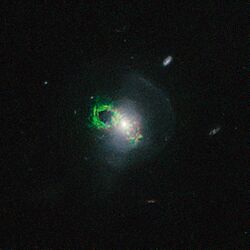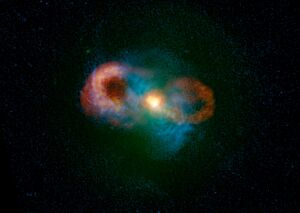Teacup galaxy facts for kids
Quick facts for kids Teacup galaxy |
|
|---|---|

The Teacup Galaxy as seen by the Hubble Space Telescope
Credit: NASA, ESA, W. Keel (University of Alabama), and the Galaxy Zoo Team |
|
| Observation data (J2000.0 epoch) | |
| Constellation | Boötes |
| Right ascension | 14h 30m 29.868s |
| Declination | +13° 39′ 11.79″ |
| Redshift | 0.08513 |
| Distance | 1,100 Mly (337.26 Mpc) |
| Apparent dimensions (V) | 0.223' × 0.197' |
| Other designations | |
| FIRST J143029.9+133912, IRAS F14281+1352, LEDA 1436754, NVSS J143030+133912, SDSS J1430+1339 | |
| See also: Galaxy, List of galaxies | |
The Teacup galaxy, also known as the Teacup AGN or SDSS J1430+1339, is a special type of galaxy with a very bright center. It has a large loop of glowing gas that looks like the handle of a teacup. This unique galaxy was found by people helping with the Galaxy Zoo project. They called the glowing loop a "Voorwerpje," which means "little object" in Dutch.
Contents
What is the Teacup Galaxy Like?
The Teacup galaxy has a large, bright central part, called a bulge. It also looks a bit uneven, with a shell shape and a long "tail" of stars. These shapes are signs that two galaxies recently crashed into each other and joined. Dark lanes of dust in the galaxy suggest this crash involved a lot of gas. Scientists using the Hubble Space Telescope have also found several groups of new stars forming in this galaxy.
Observations with the Gran Telescopio Canarias showed that the Teacup Galaxy has a huge cloud of glowing gas. This cloud stretches very far, up to 111,000 light-years! Bubbles of light and radio waves seem to be growing through the space between galaxies around it.
The Bright Heart of the Teacup Galaxy
The Teacup galaxy has a very powerful and bright center, known as an active galactic nucleus. This center is thought to contain a supermassive black hole that is actively pulling in gas and dust. When this happens, the black hole shoots out huge amounts of energy, making the center glow brightly.
At first, some scientists thought this bright center was getting dimmer. However, new observations with powerful telescopes like VLT/SINFONI showed a fast-moving stream of gas shooting out from its center. This gas moves at incredible speeds, around 1,600 to 1,800 kilometers per second!
Later studies using x-ray telescopes like Swift, XMM-Newton, and Chandra revealed that the bright center is very powerful, but also hidden by a lot of gas and dust. This new information suggests that the bright center might not be dimming after all. In fact, its brightness has only slightly decreased over the past 100,000 years.
Giant Bubbles in Space

The Teacup Galaxy with images from Hubble (blue) and the Very Large Array (orange), showing both bubbles
|
One of the most interesting features of the Teacup galaxy is its giant bubbles. Volunteers from the Galaxy Zoo project first spotted a 5,000-light-year-long loop of glowing gas in SDSS images. This loop shines brightly with specific colors, like red from hydrogen and purple from oxygen, which makes it look purple in pictures. The purple glow from oxygen is especially strong in the Teacup galaxy.
Later observations with the Very Large Array radio telescope showed two even bigger bubbles, each 10,000 to 12,000 light-years across. One is called the "eastern bubble" and matches the loop seen in regular light. The other, the "western bubble," can only be seen using radio waves. Scientists also found a bright glow to the northeast of the galaxy's center, which is fast-moving glowing gas.
These bubbles might be made by tiny jets of energy or strong winds coming from the galaxy's bright center (the quasar). Observations with the Chandra X-ray Observatory also showed a loop of x-ray emission, which matches the "eastern bubble." The Chandra data also shows hotter gas inside the bubble. This suggests that a strong wind of material is blowing away from the black hole at the galaxy's center. This powerful wind, driven by the quasar's energy, likely created these giant bubbles.
Scientists used the VLT/MUSE to study these bubbles even more. They found that the energy jets from the galaxy's center strongly push and change the gas and dust within the galaxy. At the edge of the bubbles, researchers found stars that are relatively young, around 100 to 150 million years old. This suggests that the bubbles might have helped new stars form, a process called "positive feedback" that scientists had predicted.
Further observations with the ALMA telescope showed that the radio jet is squeezing and speeding up gas molecules. This pushes gas outwards, sideways from the radio jet. This was discovered by looking at carbon monoxide gas in the galaxy.
See Also
- Extended emission-line region
- IC 2497
- Hanny's Voorwerp
- Galaxy Zoo
- Zooniverse
- List of quasars

